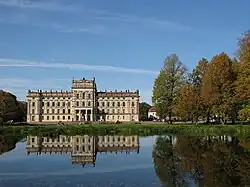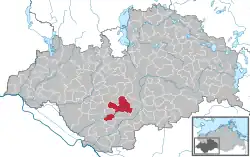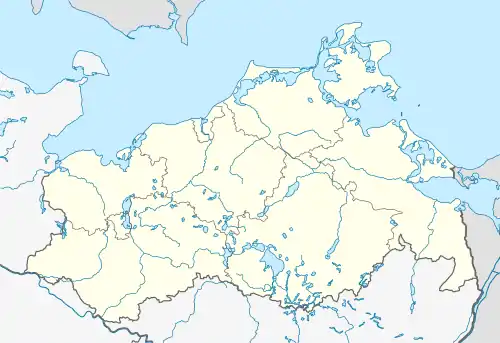Ludwigslust | |
|---|---|
 | |
 Coat of arms | |
Location of Ludwigslust within Ludwigslust-Parchim district  | |
 Ludwigslust  Ludwigslust | |
| Coordinates: 53°19′28″N 11°29′50″E / 53.32444°N 11.49722°E | |
| Country | Germany |
| State | Mecklenburg-Vorpommern |
| District | Ludwigslust-Parchim |
| Subdivisions | 7 Ortsteile |
| Government | |
| • Mayor | Reinhard Mach (Ind.) |
| Area | |
| • Total | 78.30 km2 (30.23 sq mi) |
| Elevation | 35 m (115 ft) |
| Population (2021-12-31)[1] | |
| • Total | 12,070 |
| • Density | 150/km2 (400/sq mi) |
| Time zone | UTC+01:00 (CET) |
| • Summer (DST) | UTC+02:00 (CEST) |
| Postal codes | 19288 |
| Dialling codes | 03874 |
| Vehicle registration | LWL |
| Website | stadtludwigslust.de |
Ludwigslust (German pronunciation: [luːtvɪçsˈlʊst]) is a central castle town of Mecklenburg-Vorpommern, Germany, 40 km south of Schwerin. Since 2011 it has been part of the Ludwigslust-Parchim district.
Ludwigslust is part of the Hamburg Metropolitan Region. The former royal residential town is known for its rich heritage, especially the famed Ludwigslust Palace, known as Versailles of the North.
History

In 1724 Prince Ludwig, the son of Frederick, Duke of Mecklenburg, decided to build a hunting lodge near a small hamlet called Klenow. Later, after his succession to the Dukedom, this became his favourite residence and he named it accordingly Ludwigslust ("Ludwig's pleasure/desire"). In 1765 Ludwigslust became the capital of the duchy in place of Schwerin. The town was enlarged by a residential palace (the castle). This situation continued until 1837, when Grand Duke Paul Friedrich returned the capital status to Schwerin.
The Wöbbelin concentration camp—sometimes referred to as Ludwigslust concentration camp[2]—was established by the SS near the city of Ludwigslust in 1945.[3] At the end of World War II, as the Line of contact between Soviet and other Allied forces formed, Ludwigslust was captured by British troops initially, then handed over to American troops. After several months the US troops departed and allowed Soviet troops to enter under the Yalta agreement designating the occupation of Mecklenburg to be administered by the Soviets.

Sights
- Schloss Ludwigslust, a Baroque residential palace built in 1772–1776, according to plans by Johann Joachim Busch. It is called the "Little Versailles of Mecklenburg". The palace is in the middle of the palace garden (Schlosspark), a vast park (120 ha.) in the English style, with canals, fountains and artificial cascades.
- The Stadtkirche (Municipal- / City-Church), built in 1765–1770 in Neoclassical style with Baroque sway. Its classical design, with a portico resting on six doric columns, gives the church an appearance similar to a Greek temple.
Transport
- Ludwigslust railway station is served by ICE, EC, IC and RE services.
Twin towns — sister cities
Ludwigslust is twinned with:
 Ahrensburg, Germany
Ahrensburg, Germany Muscatine, United States
Muscatine, United States Kamskoye Ustye, Russia
Kamskoye Ustye, Russia
Notable people

- Rudolph Suhrlandt (1781–1862), portrait painter and lithographer
- Franz Passow (1786–1833), a German classical scholar and lexicographer.[4] [5]
- Ludwig von Lützow (1793–1872), Mecklenburg statesman and politician
- Theodor Hahn (1824–1883), a German hydrotherapist, naturopath and vegetarianism activist.
- Franz Benque (1841–1921), photographer
- Ludwig Beissner (1843–1927), a German horticulturalist and dendrologist
- Johannes Gillhoff (1861–1930), teacher, folklorist and writer (born in Glaisin)
- Annelies Burmeister (1928–1988), contralto and actress.
- Manfred Osten (born 1938), poet, author, lawyer, former diplomat and cultural historian.
- Bernd Spier (born 1944), crooner, schlager singer and record producer.
- Christoph Biemann (born 1952), author, director and children's TV presenter
- Helmut Holter (born 1953), local politician
Aristocracy
- Frederick Louis, Hereditary Grand Duke of Mecklenburg-Schwerin (1778–1819), Hereditary Prince of Mecklenburg, Hereditary Grand Duke of Mecklenburg in Mecklenburg-Schwerin, member of the House of Mecklenburg-Schwerin
- Duchess Charlotte Frederica of Mecklenburg-Schwerin (1784–1840), duchess of Mecklenburg; Crown Princess of Denmark
- Paul Frederick, Grand Duke of Mecklenburg-Schwerin (1800–1842), Grand Duke of Mecklenburg from 1837 to 1842.
- Frederick Francis II (1823–1883), a Prussian officer and Grand Duke of Mecklenburg-Schwerin from 1842 to 1883.
- Frederick Francis III (1851–1897), the penultimate Grand Duke of Mecklenburg-Schwerin from 1883 to 1897
- Duke Paul Frederick of Mecklenburg (1852–1923), Duke of Mecklenburg, General of the Cavalry
- Duchess Marie of Mecklenburg-Schwerin (1854–1920), Grand Duchess of Russia
- Duke Christian Louis of Mecklenburg (1912–1996), nobleman, head of the house Mecklenburg
Sport
- Paul Rudolf von Bilguer (1815–1840), a German chess master and chess theoretician.
- Brigitte Kiesler (1924–2013), gymnast; competed in seven events at the 1952 Summer Olympics
- Andreas Zülow (born 1965), lightweight boxer; gold medallist at the 1988 Summer Olympics
- Birgit Jerschabek (born 1969), long-distance runner
- Bastian Reinhardt (born 1975), footballer, played over 280 games
References
- ↑ "Bevölkerungsstand der Kreise, Ämter und Gemeinden 2021" (XLS) (in German). Statistisches Amt Mecklenburg-Vorpommern. 2022.
- ↑ "Concentration Camp Listing". jewishvirtuallibrary.org. Retrieved 2008-10-12.
- ↑ Staff (1967-02-23). "Verzeichnis der Konzentrationslager und ihrer Außenkommandos gemäß § 42 Abs. 2 BEG" (in German). Bundesministerium der Justiz. Archived from the original on 2009-04-23. Retrieved 2008-10-12.
1591 Wöbbelin, Kreis Ludwigslust, Bez. Schwerin, 12.2.1945 bis 2.5.1945 Neuengamme
{{cite journal}}: Cite journal requires|journal=(help) - ↑ . New International Encyclopedia. Vol. XV. 1905.
- ↑ . Encyclopædia Britannica. Vol. 20 (11th ed.). 1911. p. 890.
External links
- official site (town)
- official site (county)
- The Embracing Forest An American visits Ludwigslust and vicinity in 2005 and finds more history than he expected.

